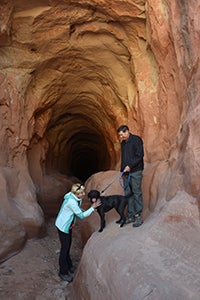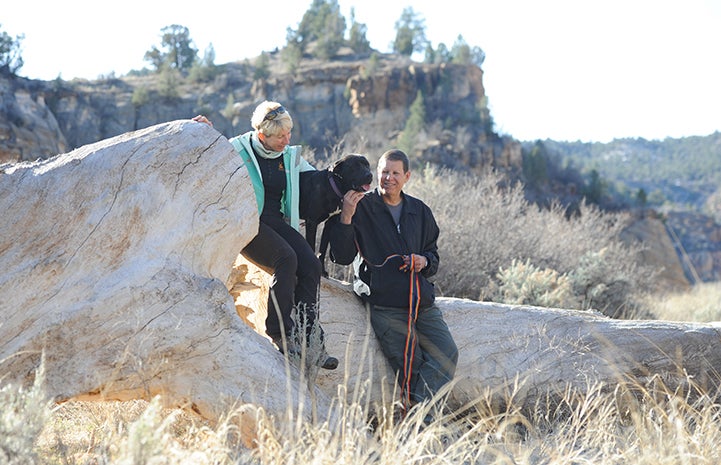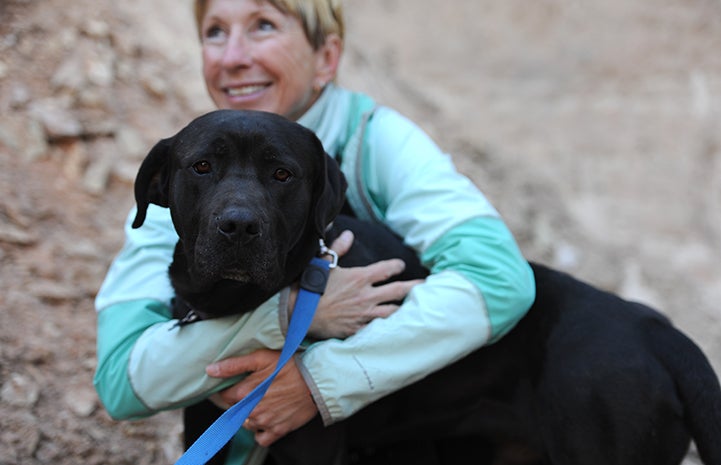Perfecting the art of winning timid dogs’ hearts


Some couples spend their vacation time lying on a beach, touring foreign cities or hiking in national parks. But for Kim and Mark Spragg, volunteering with dogs is far more fun and rewarding than any of that. That’s why, since 2012, the Florida couple has come to the Sanctuary several times a year with a schedule packed with as many dog volunteer opportunities as possible.
A soft spot for skittish dogs
In Dogtown, the Spraggs will do anything they can to help. They enjoy walking and playing with dogs who are already friendly, happy, social and likely to find homes right away. But they share a soft spot for (and focus their efforts on) Dogtown’s most timid dogs. These are the ones who need the most help to get ready for homes of their own. It’s these skittish dogs — dogs who were born shy, weren’t properly socialized, or were abused, neglected, abandoned or otherwise traumatized — who bring the couple back time after time.
Take Lava, for example. The first time Kim and Mark met the formerly feral dog, Mark just sat quietly in her yard without looking at her. Gradually, Lava sidled up to him. She also took to Kim pretty quickly.
The couple started taking her on outings, and once she got comfortable with them, they took her on a sleepover at the Best Friends cottages. There, an amazing thing happened. Lava relaxed enough in the much quieter cottages to play with toys for the first time since she came to the Sanctuary and maybe for the first time in her life. “Things can happen in the cottages that don't happen in the busy, active atmosphere in Dogtown,” says Kim.
Volunteers help with shy dog training
While that may be true, there’s quite a bit of work and training involved in getting a dog who is fearful and shutdown to open up around people. Dogtown caregivers and trainers work on socializing dogs day in and day out, spending lots of focused one-on-one time with those who need it. There are also shy dog classes, where caregivers and volunteers sit in a big circle and hold out treats to some of the shyest dogs at the Sanctuary, helping them see that people bring good things.
Then there are volunteers like Kim and Mark, who Dogtown staff rely on to help dogs like Lava take that challenging but important next step. Once a shy dog has worked extensively with caregivers and trainers and is ready to do some trial outings and sleepovers with volunteers, these special helpers step in.
The dogs not only benefit greatly from getting to know and trust people in addition to caregivers and trainers, but they also get to discover different places around the Sanctuary where they can get more exposure to the world. And if they handle the experience well — without becoming too stressed, anxious or shutting down — they can be approved for outings and sleepovers with a much broader base of volunteers. When a dog needs a little extra help to reach that milestone, Kim and Mark are the perfect mentors.
A dynamic dog socialization duo
“Part of the reason dogs like us is that we're boring and quiet,” Kim laughs. Both she and Mark do have a calm, steady air about them that inspires trust in even the shyest dogs. But the dynamic dog socialization duo has also put a lot of effort into perfecting the art of winning shy dogs’ hearts at the Sanctuary.
They've spent a great deal of time watching dogs and studying their behavior to better understand them. Every time they volunteer, they learn all they can from Dogtown caregivers. And they’ve taken several dog behavior and handling workshops at the Sanctuary.
Learn about Best Friends’ dog behavior and handling workshops

Kim and Mark are also patient people. In the case of Lava and some other dogs, they don’t expect big breakthroughs overnight. They are willing to give them as much time as they need and to build relationships slowly. They are always careful to respect their need for space, and they let dogs approach them at their own pace. If they don't make progress with a particular dog during one visit, they’ll try again on their next trip if that dog is still at the Sanctuary.
A sense of satisfaction
With each return trip to Best Friends, the list of dogs Kim and Mark have helped continues to grow. That list includes Dancing Lady, a very shy collie and chow-chow mix. Once they got special approval, they took her on her very first sleepover and then continued taking her on sleepovers every time they visited over the next few years. They found that her favorite thing to do was to go for walks — especially long cross-country, off-trail walks. Mark says, “I think the bonding on our walks allowed her to build trust and tolerate (and even enjoy) her in-cabin time.” She's since been adopted.
Kim and Mark can name plenty of other dogs they’ve bonded with over the years. But for them, it’s not about quantity, but the quality of the relationships they build. It’s also about helping each dog get one step closer to a forever home.
“Helping these dogs gives us a sense of satisfaction and makes us feel like we are contributing to the important work Best Friends is doing,” the couple says. And that’s something they can’t get while lounging on any beach in the world.

Photos by Molly Wald